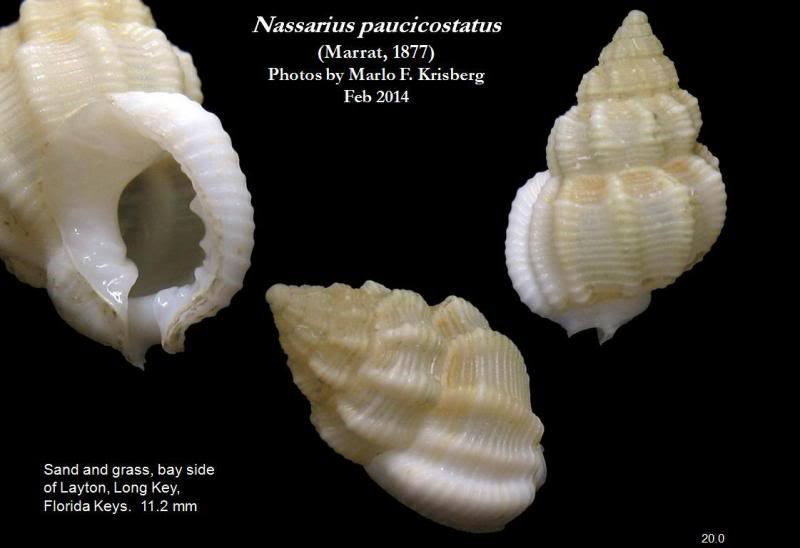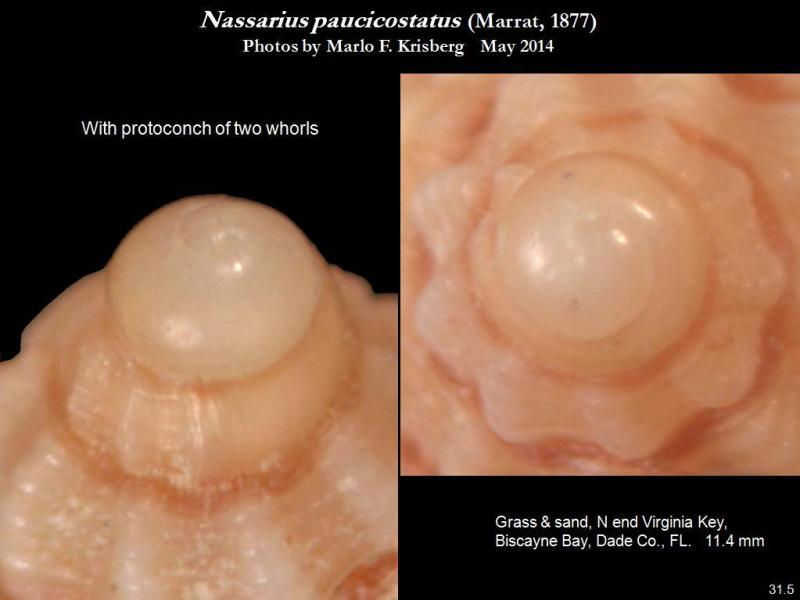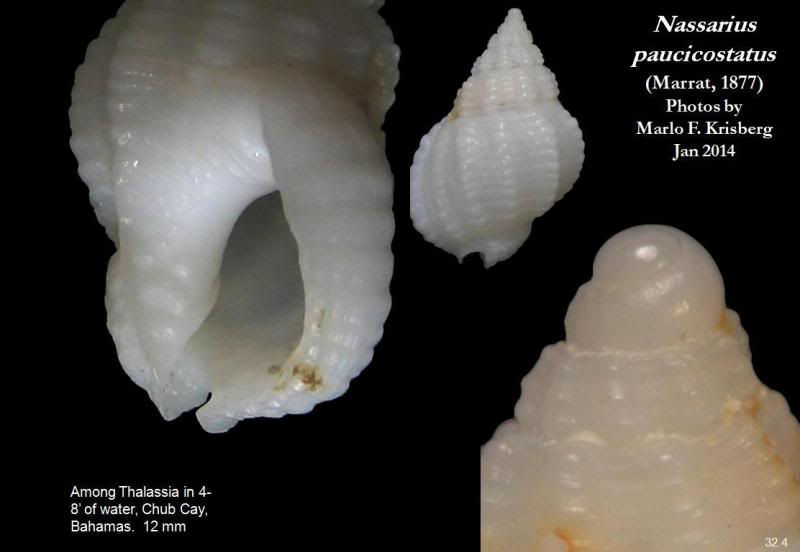
Posted: Feb 21 2006
Nassarius paucicostatus (Marrat, 1877)
I’ve been collecting in Florida for a long, long time and for all that time there has been a group of white (most of the time) Nassarius that created a bit of consternation.
Through the ‘80s and ‘90s Abbott’s (1974) treatment of North American Nassarius dominated. Abbott presented “Nassarius albus (Say, 1826) Variable Nassa” and described it as “this unusually variable species.” He suggested “N. consensus (Ravenel, 1861) is possibly only a form” and specified as synonyms “ambiguus Pulteney, 1799, non Solander, 1766; antillarum Orbigny, 1842;” and others. Abbott did not mention N. paucicostatus (Marrat, 1877), which is also confused as part of this group. Rehder (1981) presented only “Nassarius albus” and made no mention of the “synonymous” names listed by Abbott. (Note: Rehder's description and photo are not N. albus - see slide after #11 below.) Subsequent to Abbott and Rehder workers have given species status to these various taxa, but only Redfern (2001) has presented extensive descriptions, including distinguishing characters, for three of them; namely, N. albus, N. antillarum, and N. paucicostatus. Kaicher (1982) and Lee (1998 and 2009) have also provided tidbits that are helpful in ascertaining observational consistency upon which to draw conclusions.
Because so many workers up to Rehder considered N. albus, the earliest named Western Atlantic Nassarius of this group, to be an “unusually variable species,” and did not distinguish it from the others, we cannot rely upon their descriptions, since they may be inclusive of characters we now would identify with other species. This circumstance has given rise to many presentations of specimens as N. albus that subsequently were considered other (or potentially other) similar taxa, and referred to as N. albus of authors non Say, meaning labeled as N. albus by workers, but not the same as Say’s N. albus. These could very well have been forms of N. paucicostatus.
The problem is that the early descriptions of many of these taxa were insufficient and lacked comparative distinctions between similar taxa. Good figures were lacking and type material was not preserved or has been lost. It was just too early in the development of scientific methods, too little comprehensive material was available, and there was a lack of scientific self-discipline. Many have tried to reconcile these taxa, but these deficiencies have made it impossible for there to be accuracy and, in fact, the many interpretations have just added to the confusion. Until a comprehensive DNA-based analysis is performed, distinct species identified and linked to known type material, neotypes designated for existing species names, and new species identified, if applicable, we will not be able to identify many of Florida’s “white” Nassarius with confidence.
With this presentation (and those for the others in this group), I am attempting to extract from the original descriptions those few descriptive characters that appear to be unique to each species, also utilize those few works that presented a comparative analysis pointing out unique characters, link them to a consistent protoconch, and separate all my little white Florida Nassarius accordingly. I intend to present N. consensus, N. paucicostatus, N. antillarum, N. albus, and those that do not fit any of these. My preliminary conclusion is that all the little white Florida Nassarius are variations of N. consensus, N. paucicostatus, N. albus or are unnamed, and that N. antillarum does not occur in Florida.
Here is a list of the confused taxa in this group:
N. albus (Say, 1826)
No type or figure. From the context of Say’s presentation, it appears his description is based upon a single shell from the “Southern Coast of East Florida,” which he felt was “in no respect different from specimens brought from the West India Islands,” with which he was apparently familiar.
N. consensus (Ravenel, 1861)
No type or figure
N. antillarum (d’Orbigny, 1847)
d’Orbigny’s description is based upon a group of syntypes. However, Kaicher found that only two specimens in the group truly matched d’Orbigny’s description. One of these two is illustrated in Kaicher card 3232. When De Jong & Coomans (1988) examined the nine syntypes present in BMNH they also found that they all did not match d’Orbigny’s description and, as a result, designated d’Orbigny’s figure as the lectotype
N. ambiguus (Pulteney, 1799)
No type or figure. The shell described was of Mediterranean fauna. (Doubtful that this name should be assigned to a western Atlantic shell.) Shells from western Atlantic assigned this name are either variations of one of the others or an unnamed species. Kaicher (1982) and more recently Lee (personal correspondence) have pointed out that "Buccinum ambiguum Pulteney, 1799 is unavailable under the provisions of the Code since it is a primary junior homonym of B. ambiguum Solander ]in Brander, 1766 (28; fig. 56), an available name applied to a fossil from Hampshire, U.K."
N. paucicostatus (Marrat, 1877)
No known authentic illustrations.
N. albus auct. non Say (Kaicher card 3234) and N. albus of authors non Say
These are the many specimens presented as N. albus but which cannot accurately be assigned this name and may be any of the above or as yet are innominate.
Thanks to Harry Lee’s efforts I was
able to obtain a copy of Marrat’s
original description (without a figure)
of N. paucicostatus.
It is instructive that when Marrat (1880) reviewed the “Genus Nassa, Lam.” he began by answering the question “What are the shells described in the following pages,” by stating “My answer to this question is, I do not know.” He acknowledged that his “amount of knowledge is confined to the single specimens in most instances, and to three or four at most, in any case.”
There is little to rely upon in Marrat’s description to help us separate N. paucicostatus, but for his indication that “columella callused, rough.” If we interpret “rough” to mean the columella and parietal callus were covered with
bumps, pustules, ridges, etc., then this would distinguish N. paucicostatus from similar taxa in this group.
The first presentation I could find that distinguished the taxa in this group
was Kaicher (1982). Her card #3206 presents N. paucicostatus. We don’t
know how Kaicher decided this specimen was N. paucicostatus, but it
conforms to Marrat’s description, particularly having a columella and
parietal callus covered with bumps, pustules, and ridges. It appears that
Kaicher’s card #3206 is the reference many subsequent workers have
relied upon. The key additional character provided by Kaicher, accepting
that she has illustrated the true N. paucicostatus, is that it has a smooth, 1½
whorled protoconch with the bottom portion being rather bulbous. This
feature alone separates N. paucicostatus from most others in this group.
Lee (1998) appears to have accepted Kaicher’s assignment in the curation of his collection of Western Atlantic Nassariidae, agreed that the protoconch was “globose crawl-away,” added, consistent with Kaicher’s photo, “well-developed parietal ornamentation,” and noted that in Florida N. paucicostatus was found only in southeast Florida. Redfern (2001) reported and provided a detailed description and a good photo of the protoconch of specimens he considered to be N. paucicostatus. While many of the described characters are variable in nature and would apply to many or all of the shells in this group, he does provide a few that, when matched with Lee’s descriptors, do help to distinguish N. paucicostatus; namely, lacking shouldering (as in the keeled shoulders of N. antillarum or sometimes knobbed shoulders of N. consensus), strong lirae extending into aperture, and often a dark orange-brown subsutural band, a paler band about at the periphery of the body whorl, and another around the base. When these latter bands are present the color is in the interspaces and not on the cords.
Assuming the validity of Kaicher’s, Lee’s and Redfern’s descriptions as applying to Marrat’s N. paucicostatus, the characters taken together that distinguish this taxon from the others in this group are:
1. Protoconch with 1½ smooth whorls* with the bottom portion being rather bulbous.
2. Well-developed parietal ornamentation (usually with ridges and pustules over entire columella and parietal callus).
3. Axial ribs not keeled or shouldered
4. Strong lirae inside lip extending into aperture
5. Dark orange-brown subsutural band
6. When color bands present on body whorl, color is usually in the interspaces and not on the cords.
*After reviewing numerous lots of populations from Key West to Biscayne Bay, each lot being composed of shells collected together on the same date and locale, I have found that while the vast, vast majority have 1½ protoconch whorls, a small number have protoconchs that reach 2 whorls.
------------------------------------------------------------------------
References
Abbott, R. Tucker. 1974 American Seashells, Second Edition, Van Nostrand Reinhold Company.
Brander, G., 1766. Fossilia Hantoniensia collecta, et in Musæo Britannico deposita. London. i-vi + 1-43, plates 1-9.
Cernohorsky, W. O., 1975. The taxonomy of some west American and Atlantic Nassariidae based on their type-specimens. Records of the Auckland Institute and Museum 12: 121-173.
Cernohorsky, W. O., 1984. Systematics of the family Nassariidae (Mollusca: Gastropoda). Bulletin of the Auckland Institute and Museum 14: i-iv, 1-356.
Kaicher, S. D., 1982. Card catalogue of worldwide shells. Pack #31 - Nassariidae Part I. Privately printed, St. Petersburg FL, 108 cards.
De Jong, K. M. and Coomans, H. E. 1988. Marine Gastropods from Curacao, Aruba and Bonaire. Institute of Taxonomic Zoology, University of Amsterdam.
Kaicher, S. 1982. Kaicher's Card Catalogue of World-Wide Shells. Pack #31 - Nassariidae Part 1. Privately printed, St. Petersburg FL, 108 cards.
Lee, Harry G. December 1998. Western Atlantic Nassariidae. American Conchologist 26 (4): 18-20.
Lee, Harry G. 2009. Marine Shells of Northeast Florida. Jacksonville Shell Club, Jacksonville, Florida.
Lee, H.G. July 2013. Nassa update: Application of the genus-level taxon Uzita H. and A. Adams , 1853 to a large and ubiquitous group of nassariids (Gastropoda: Buccinoidea). Shell-O-Gram 54(4): 6-7.
Lyons, William G. November 1989. Nearshore Marine Ecology at Hutchinson Island, Florida: 1971-1974, XI. Mollusks. Florida Marine Research InstituteNo. 47.
Marrat, F. P. 1880. On the varieties of the shells belonging to the genus Nassa, Lam. (1880). The Argus Printing and Stationery Co. Limited, Liverpool.
Redfern, Colin. 2001. Bahamian Seashells: A Thousand Species from Abaco, Bahamas. Bahamianseashells.com, Inc: Boca Raton, Florida.
Rehder, Harald A. 1981. The Audubon Society Field Guide to North American Seashells. Alfred A. Knopf, New York.


This presentation is very long and has 5 galleries. Be sure to scroll down to view all five galleris.
Gallery 1


















Gallery 2




















Gallery 3




















Gallery 4




















Gallery 5



